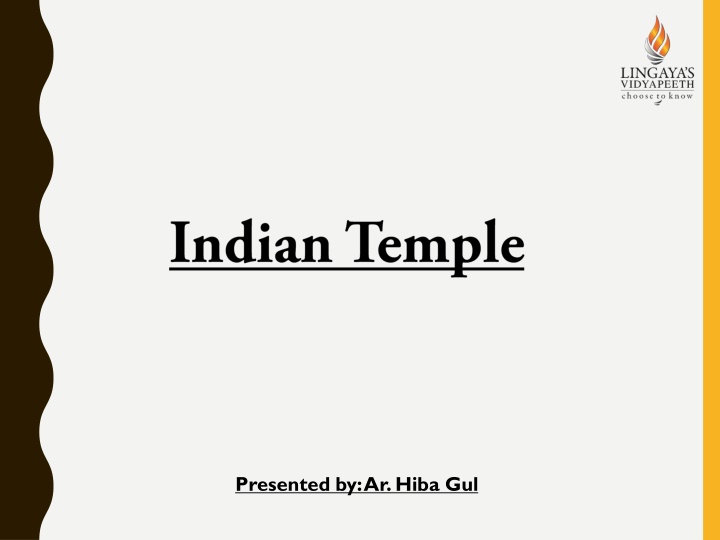Magnificent Temples of Khajuraho and Orissa: A Glimpse into Ancient Indian Architecture
Explore the architectural wonders of Khajuraho and Orissa, highlighting the exquisite craftsmanship, intricate sculptures, and unique design styles of the temples. Witness the beauty of the Kendariya Mahadeo temple, the rich cultural heritage depicted in the sculptures, and the distinctive Kalinga style of Eastern Indian temples in Orissa. Immerse yourself in the historic significance and architectural excellence of these ancient marvels that continue to captivate visitors with their grandeur and artistry.
Download Presentation

Please find below an Image/Link to download the presentation.
The content on the website is provided AS IS for your information and personal use only. It may not be sold, licensed, or shared on other websites without obtaining consent from the author.If you encounter any issues during the download, it is possible that the publisher has removed the file from their server.
You are allowed to download the files provided on this website for personal or commercial use, subject to the condition that they are used lawfully. All files are the property of their respective owners.
The content on the website is provided AS IS for your information and personal use only. It may not be sold, licensed, or shared on other websites without obtaining consent from the author.
E N D
Presentation Transcript
KHAJURAHO GROUP OFTEMPLES The temples have been built from granite or sandstone, the two chief rocks found in this area upon raised platforms. The platforms themselves stand on solid rock masses that are one of the oldest rocks on this earth.
The Kendariya Mahadeo temple is the finest example in Indo-Aryan temple style because of its attainment of unity in design of its components such as mandapas. It becomes a composite design in plan and exterior profile. It results into overall jagged profile of mostly revered Kailash. The raised platform on which the temples stands in itself becomes dominant feature of the composition. The great flight of steps gives one a sense of arrival in higher ritualistic sense also.
The sculpturesare exquisite. They show the daily lives of the kings (hunting etc), Deities in their various forms, Beautiful apsarases in their elegant and enticing postures Royal motifs like lions and elephants.
EASTERN INDIAN TEMPLES OFORISSA Under the ancient name of Kalinga, Orissa was the seat of great empires as far back as 300 B.C. as the most remarkable examples of architectural achievement in all ofAsia. Although Orissa presents a fairly large variety of styles in temple building, it has nevertheless a characteristic architectural genius. Its temples have been described as one of the most compact and homogeneous architectural groups in India. In these the Indo-Aryan style of architecture may be seen at its best and purest.
EASTERN INDIAN TEMPLES OFORISSA The design which flourished in eastern Indian state of Orissa and Northern Andhra Pradesh are called Kalinga style of architecture. The style consists of three distinct type of temples namely Rekha Deula, Pidha Deula and Khakhara Deula. Deula means "Temple" in the local language. The former two are associated with Vishnu, Surya and Shiva temple while the third is mainly with Chamunda and Durga temples. The Rekha deula and Khakhara deula houses the sanctum sanctorum while the Pidha Deula constitutes outer dancing and offering halls. The prominent examples of Rekha Deula are Lingaraj Temple of Bhubaneswar and Jagannath Temple of Puri. The Konark Sun Temple is a living example of Pidha Deula.
The temple-building movement in Orissa, which reached its peak of excellence in the 10th and 11th centuries, stretches from roughly 650 A.D. to 1200 A.D. and illustrates more coherently than any other similar movement the growth and development of the Nagara style ofarchitecture. In general, all Orissan temples follow a common structuralplan. A typical temple consists of twoapartments. The deul, corresponding to the southern vimana, is the cubical inner apartment which enshrines the image, and is surmounted by atower. In front of this is the antarala or porch called the jaganmohan whichis usually square-shaped and has a pyramidalroof. Occasionally, one or two more mandapas, such as the natmandir and the bhogmandir, can be found in front of the jaganmohan, but these, where they exist, are almost without exception were superimposed on top of the originalplan.
The Orissan temples have two parts namely the sanctum (deul or vimana) and the other is place from where pilgrims view the sanctum (called jagamohana). The initial deul temples were without the jagamohana as seen in some of the older temples in Bhubaneswar, while the later temples had two additional structures namely nata-mandapa (festival hall) and bhoga-mandapa (hall of offerings). The vimana is square in plan and the walls are variegated by ressaults . Amalaka (also called mastaka), a stone disk with ridges on the rim is placed over the bada (tower) of the temple.
Bhubaneswar has the richest profusion of temples and is known as the temple town of Orissa, not only because of the large number of temples found there, but also because it is the home of the famous Lingaraja temple.
LINGARAJATEMPLE The great Lingaraja temple, believed to have been built around 1000A.D. It stands in a cluster of sixty-five smaller shrines in a spacious compound meausring 520 feet by 465 feet Its mighty tower (the vimana) dominates the landscape for miles around. Constructed without mortar, this tower is 127 feet high and is divided into vertical sections. The angles of the recesses are filled in with miniature vimanas and on the top, are figures representing a lion crushing an elephant.
Initially it consisted of a cella and a mandapa Cella 56ft square and rises about 140 ft Mandapa is rectangular
Lingaraj Temple is a Hindu temple dedicated to Harihara, a form of Shiva and is one of the oldest temples in Bhubaneswar, the capital of the East Indian state of Odisha (formerly Orissa). The temple is the most prominent landmark of the Bhubaneswar city and one of the major tourist attractions of the state Lingraja temple























